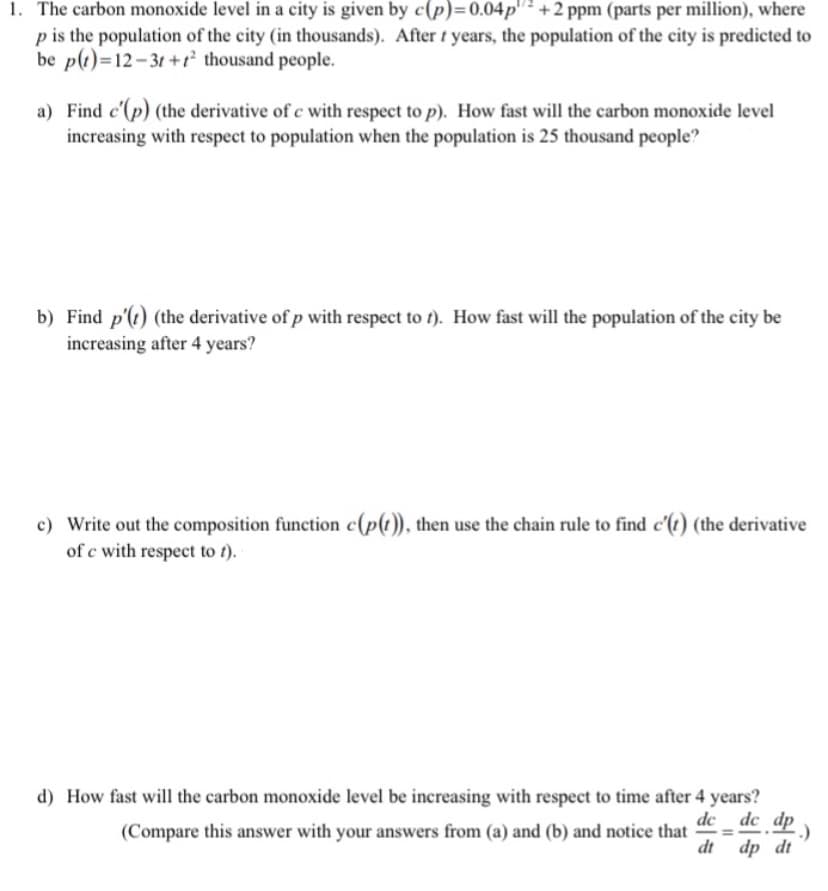· The carbon monoxide level in a city is given by c(p)=0.04p" +2 ppm (parts per million), where p is the population of the city (in thousands). After t years, the population of the city is predicted to be p(1)=12-31 +r thousand people. a) Find c'(p) (the derivative of c with respect to p). How fast will the carbon monoxide level increasing with respect to population when the population is 25 thousand people? b) Find p'(t) (the derivative of p with respect to f). How fast will the population of the city be increasing after 4 years? c) Write out the composition function c(p(t)), then use the chain rule to find c'(t) (the derivative of c with respect to t).
· The carbon monoxide level in a city is given by c(p)=0.04p" +2 ppm (parts per million), where p is the population of the city (in thousands). After t years, the population of the city is predicted to be p(1)=12-31 +r thousand people. a) Find c'(p) (the derivative of c with respect to p). How fast will the carbon monoxide level increasing with respect to population when the population is 25 thousand people? b) Find p'(t) (the derivative of p with respect to f). How fast will the population of the city be increasing after 4 years? c) Write out the composition function c(p(t)), then use the chain rule to find c'(t) (the derivative of c with respect to t).
Calculus: Early Transcendentals
8th Edition
ISBN:9781285741550
Author:James Stewart
Publisher:James Stewart
Chapter1: Functions And Models
Section: Chapter Questions
Problem 1RCC: (a) What is a function? What are its domain and range? (b) What is the graph of a function? (c) How...
Related questions
Question
100%
Please help with this.

Transcribed Image Text:1. The carbon monoxide level in a city is given by c(p)=0.04p"² +2 ppm (parts per million), where
p is the population of the city (in thousands). After t years, the population of the city is predicted to
be p(1)=12-31 +r thousand people.
a) Find c'(p) (the derivative of c with respect to p). How fast will the carbon monoxide level
increasing with respect to population when the population is 25 thousand people?
b) Find p'(t) (the derivative of p with respect to t). How fast will the population of the city be
increasing after 4 years?
c) Write out the composition function c(p(t)), then use the chain rule to find c'(t) (the derivative
of c with respect to t).
d) How fast will the carbon monoxide level be increasing with respect to time after 4 years?
de _ dc dp )
(Compare this answer with your answers from (a) and (b) and notice that
%3D
dt dp dt
Expert Solution
This question has been solved!
Explore an expertly crafted, step-by-step solution for a thorough understanding of key concepts.
This is a popular solution!
Trending now
This is a popular solution!
Step by step
Solved in 5 steps with 3 images

Recommended textbooks for you

Calculus: Early Transcendentals
Calculus
ISBN:
9781285741550
Author:
James Stewart
Publisher:
Cengage Learning

Thomas' Calculus (14th Edition)
Calculus
ISBN:
9780134438986
Author:
Joel R. Hass, Christopher E. Heil, Maurice D. Weir
Publisher:
PEARSON

Calculus: Early Transcendentals (3rd Edition)
Calculus
ISBN:
9780134763644
Author:
William L. Briggs, Lyle Cochran, Bernard Gillett, Eric Schulz
Publisher:
PEARSON

Calculus: Early Transcendentals
Calculus
ISBN:
9781285741550
Author:
James Stewart
Publisher:
Cengage Learning

Thomas' Calculus (14th Edition)
Calculus
ISBN:
9780134438986
Author:
Joel R. Hass, Christopher E. Heil, Maurice D. Weir
Publisher:
PEARSON

Calculus: Early Transcendentals (3rd Edition)
Calculus
ISBN:
9780134763644
Author:
William L. Briggs, Lyle Cochran, Bernard Gillett, Eric Schulz
Publisher:
PEARSON

Calculus: Early Transcendentals
Calculus
ISBN:
9781319050740
Author:
Jon Rogawski, Colin Adams, Robert Franzosa
Publisher:
W. H. Freeman


Calculus: Early Transcendental Functions
Calculus
ISBN:
9781337552516
Author:
Ron Larson, Bruce H. Edwards
Publisher:
Cengage Learning